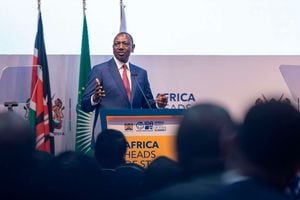Barclays Bank plans to employ more disabled people

Dr David Ole Sankok, the chairman of the National Council of Persons with Disabilities, treats a patient in his Loita Lab Medical Clinic in Narok town on February 9, 2011. Dr Sankok complains that many employers are yet to embrace policies that would see the actualisation of equal employment opportunities and training for people with diasabilities. PHOTO | PHOEBE OKALL |
What you need to know:
- The video serves to demonstrate some of the physical adjustments the bank has undertaken to accommodate more employees with disability within its ranks.
- Statistics indicate that in Kenya, more than 33 per cent of physically challenged persons do not have any form of employment, while 25 per cent work in family businesses.
The video footage pans to one side and then the other, and zooms in conveniently to show details of the expanded washrooms, the access ramps and lowered ATMs.
It is November 14 at KICC Nairobi, and Barclays Bank of Kenya is unveiling its disability plan under the multinational’s Diversity and Inclusion policy.
The occasion doubles up as a career fair specially targeted at people with disabilities.
The video serves to demonstrate some of the physical adjustments the bank has undertaken to accommodate more employees with disability within its ranks.
It targets a five per cent representation of such staffs. Presently, according to human resource director Geneva Musau, the bank is at one per cent on this score, aiming to get to three per cent by 2016.
“We feel that much has not yet been done to equally represent persons with disability,” Ms Musau confesses.
According to the International Labour Organisation (ILO), many disabled people in Kenya, as in most developing countries, have limited employment opportunities, sometimes spawned by poor access to education.
“Productive and decent work enables people with disabilities to realise their aspirations, improve their living conditions and participate more actively in society,” states ILO on a website write-up.
EQUAL OPPORTUNITIES
The organisation underscores the need for equal employment opportunities and training for such people.
Dr David Ole Sankok, the chairman of the National Council of Persons with Disabilities, complains that many employers are yet to embrace policies that would see the actualisation of such advice by ILO.
“We still have physically challenged people being mistreated and discriminated against by some employers,” he says.
The UN Convention on the Rights of Persons with Disabilities and Optional Protocol also seeks to promote the employment of persons with disabilities an equal terms with others.
“This includes the right to the opportunity to gain a living by work freely chosen or accepted in a labour market and work environment that is open, inclusive and accessible to persons with disabilities,” the resolution indicates.
Statistics indicate that in Kenya, more than 33 per cent of physically challenged persons do not have any form of employment, while 25 per cent work in family businesses.
INCLUSIVE CULTURE
Driven by its diversity and inclusion programme, Barclays Kenya now seeks to root a culture of promoting equal employment opportunity for such persons.
“This year, we formed the Barclays Kenya Diversity and Inclusion Council, which will focus on the four key pillars. Already we have seen the gender pillar successful and now our focus is on disability,” says Hannah Gitau, who chairs the council.
“Creating an inclusive culture is about recognising and appreciating that all human beings have been created differently but equal,” she explains and continues:
“This diversity and inclusion initiative is about checking our own behaviour – conscious and unconscious – towards those that we feel are different from us.”
Ms Musau identifies pertinent factors with which the company aims to achieve the set five per cent employment threshold of persons with disability.
“In our policy, we’ve had the senior leadership team undergo ‘unconscious bias’ training to enable them pick up on the nuances that they send out when going about their daily routine as a result of their socialisation, which could be inhibiting the promotion of diversity and inclusion in the work place,” she says.
ENGAGE WITH DISABLED
The training, she quickly adds, will be cascaded to all staff members.
“We acknowledge that people with disabilities are not adequately represented within our ranks, and we have therefore put in place a policy which will see us increase their numbers year-on-year until we get to the five per cent government threshold,” says Mr Francis Okomo, the chairman of the Board Of Directors Of Barclays Bank of Kenya.
At the launch, Ms Musau said she hoped the initiative would challenge the rest of the corporate world to engage with physically challenged people on a similar basis.





